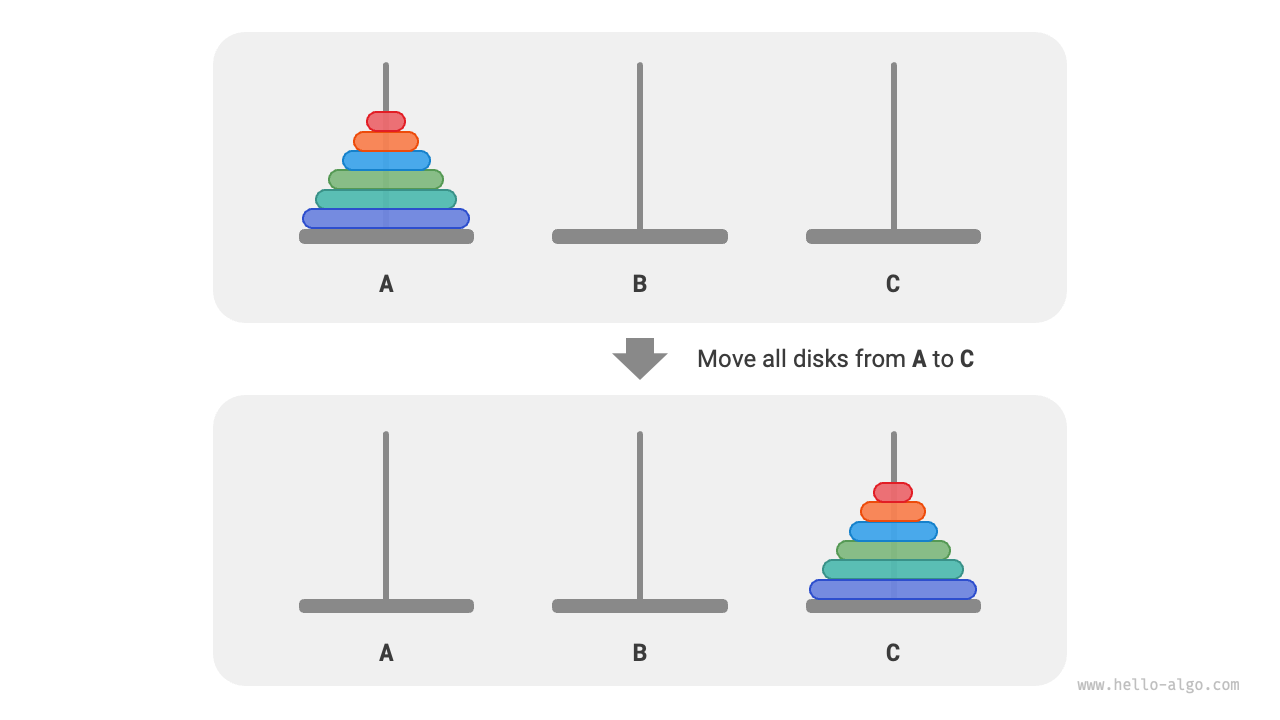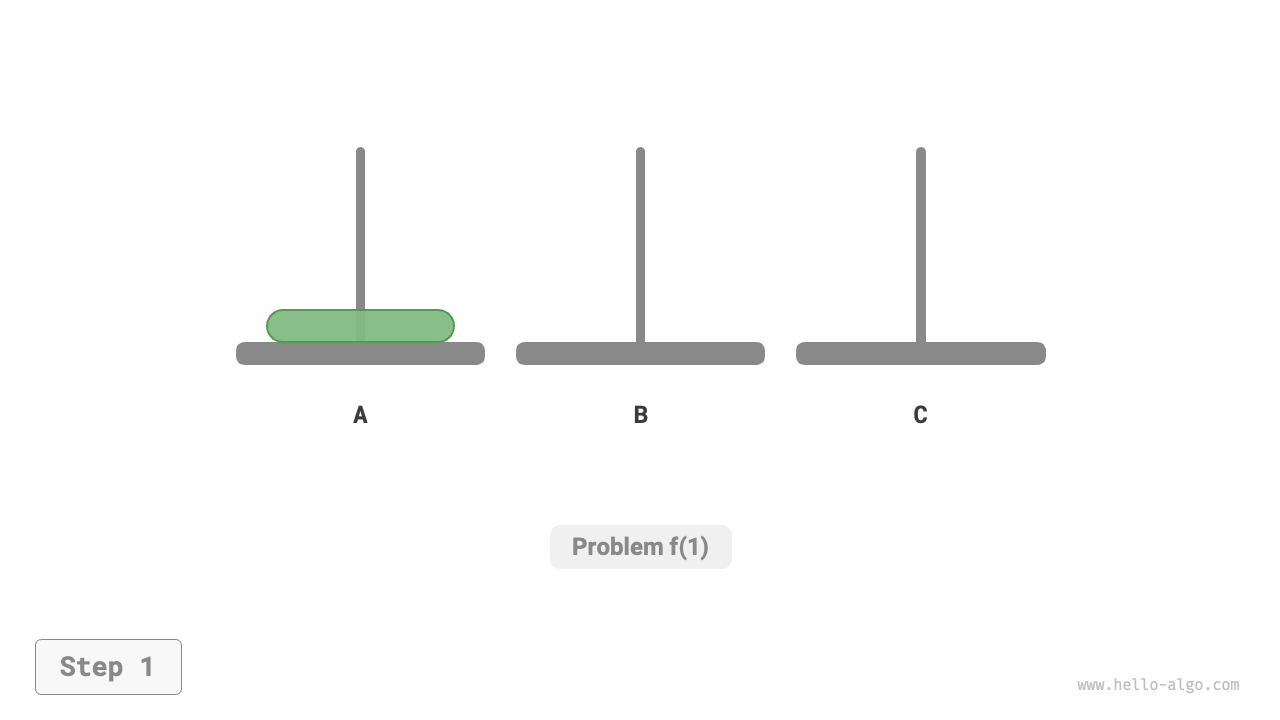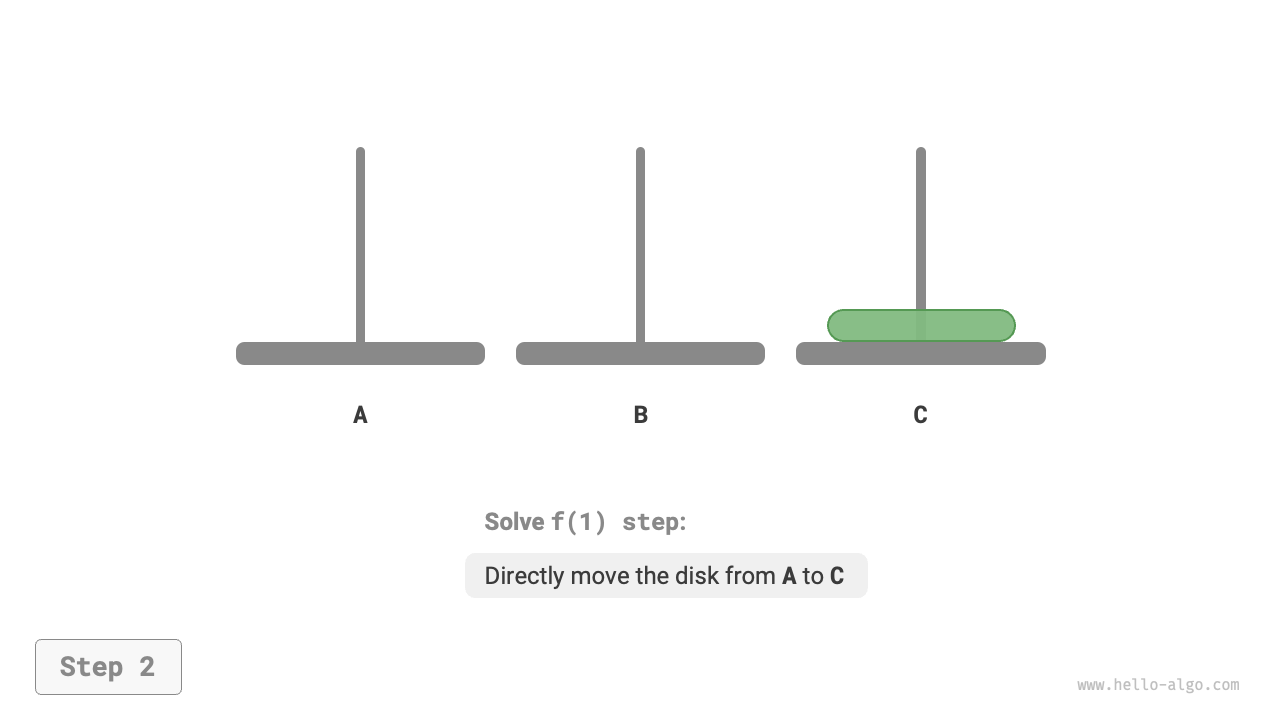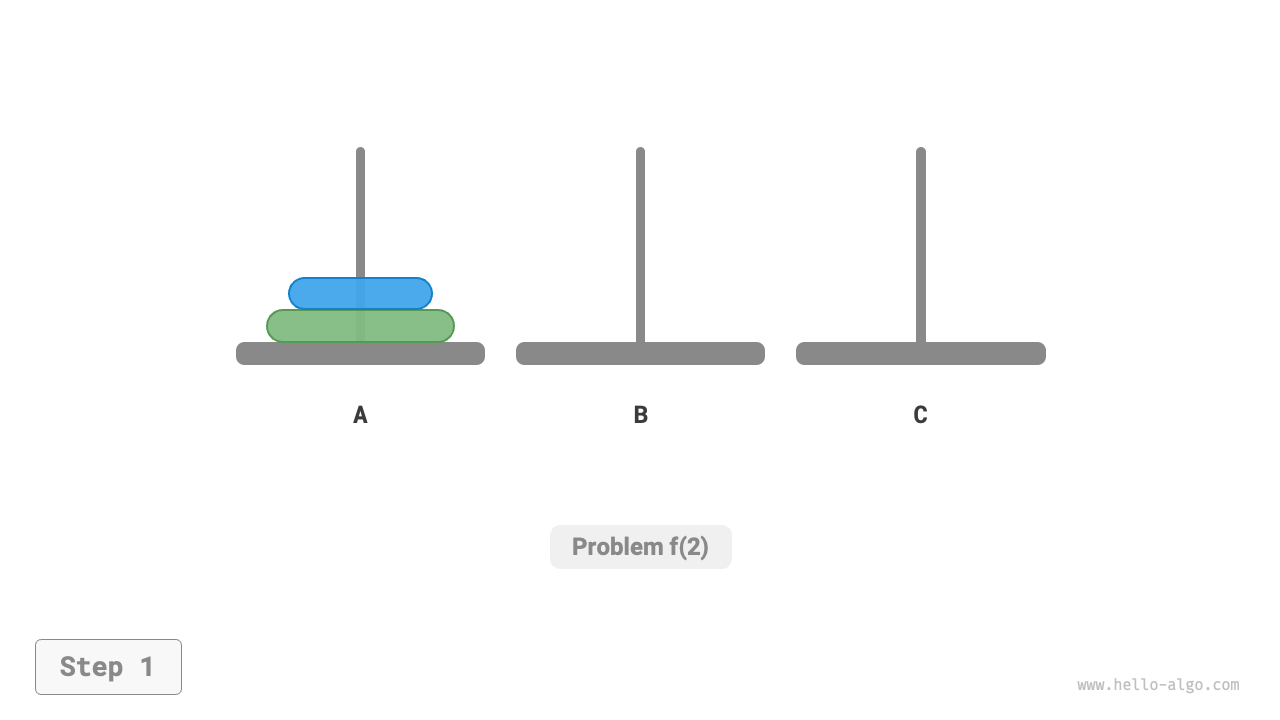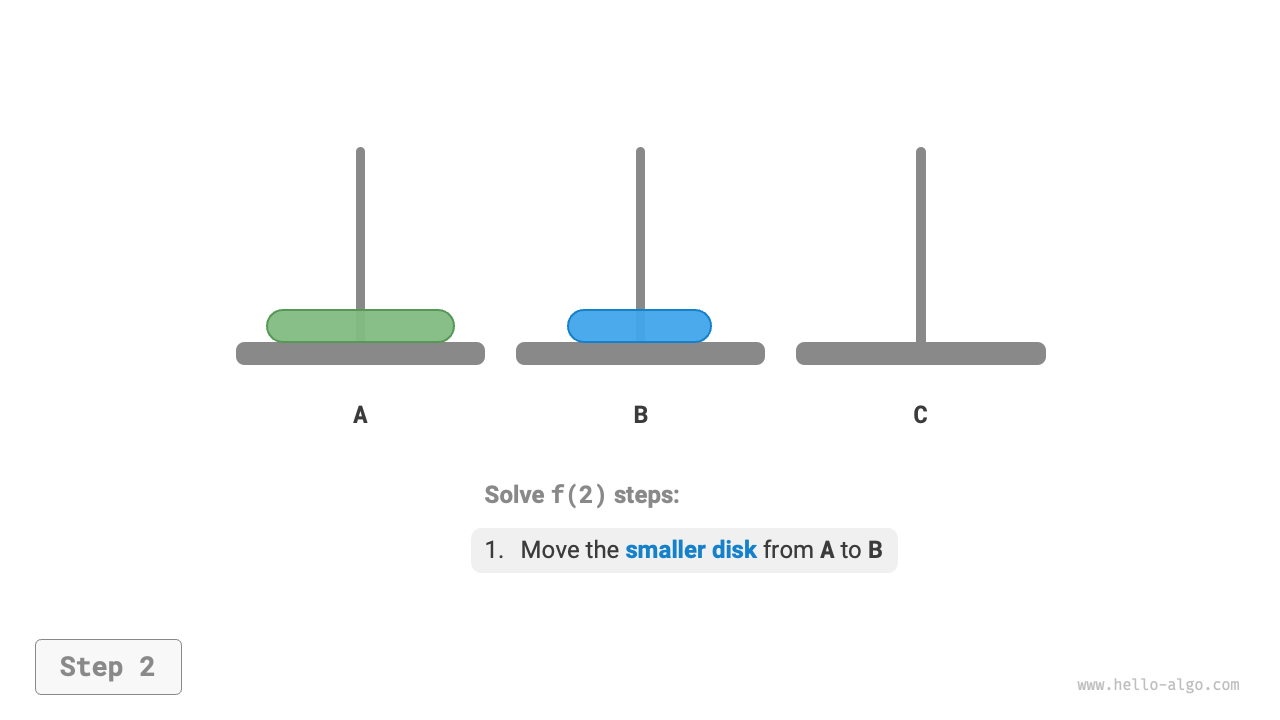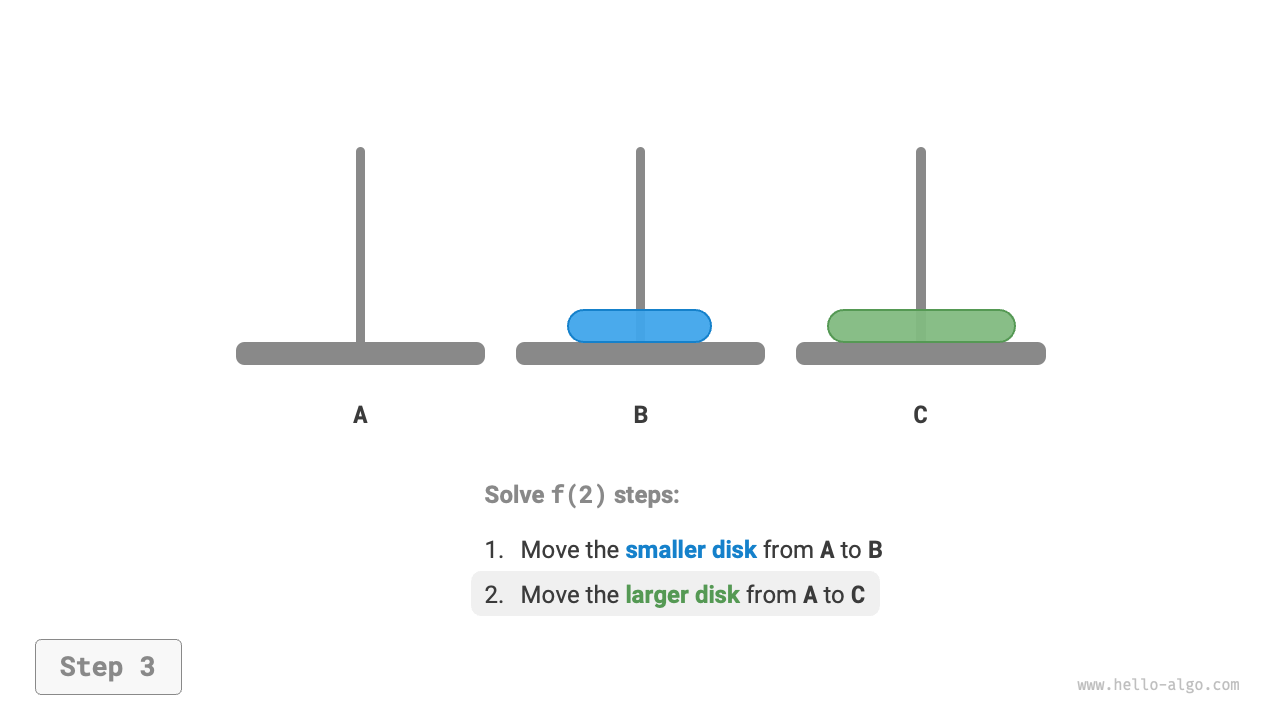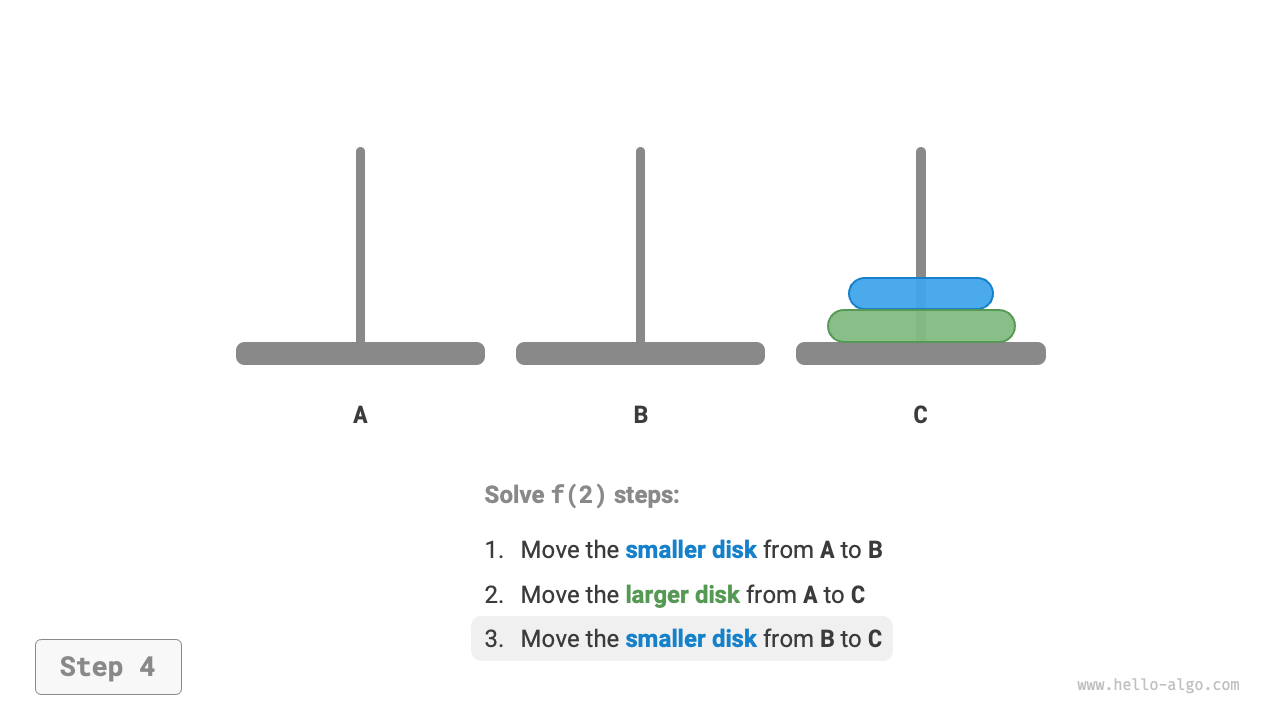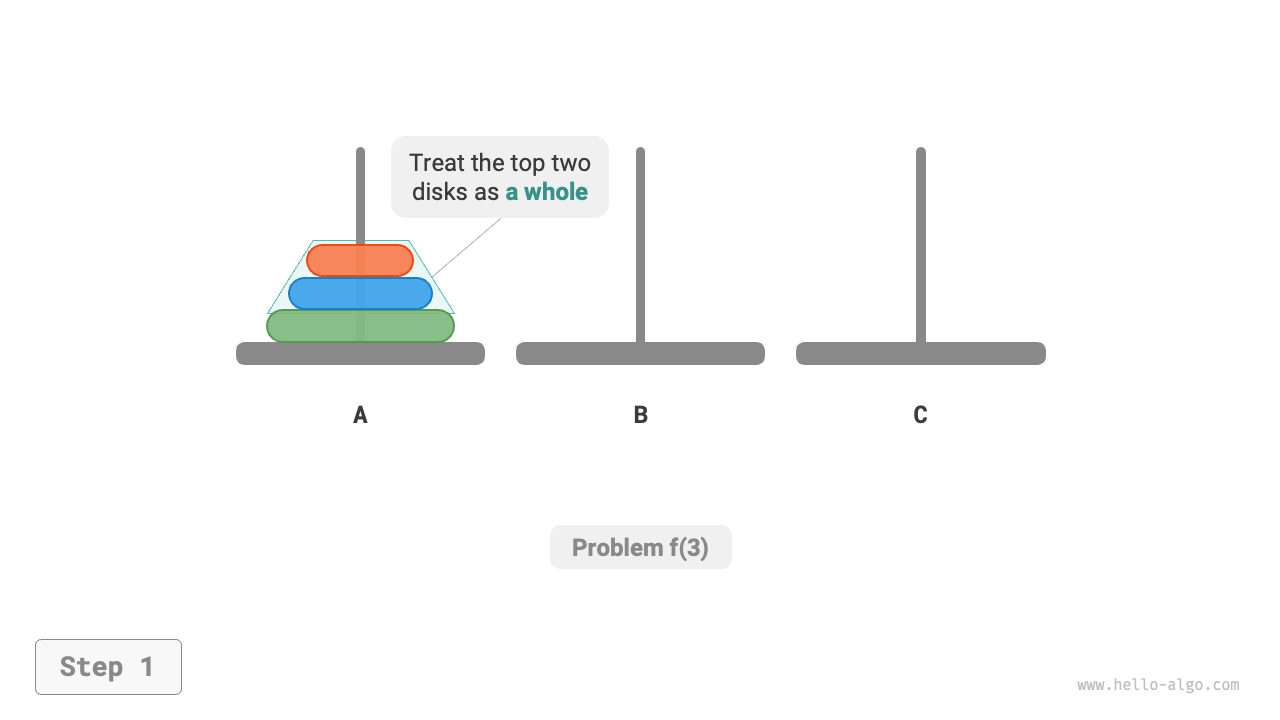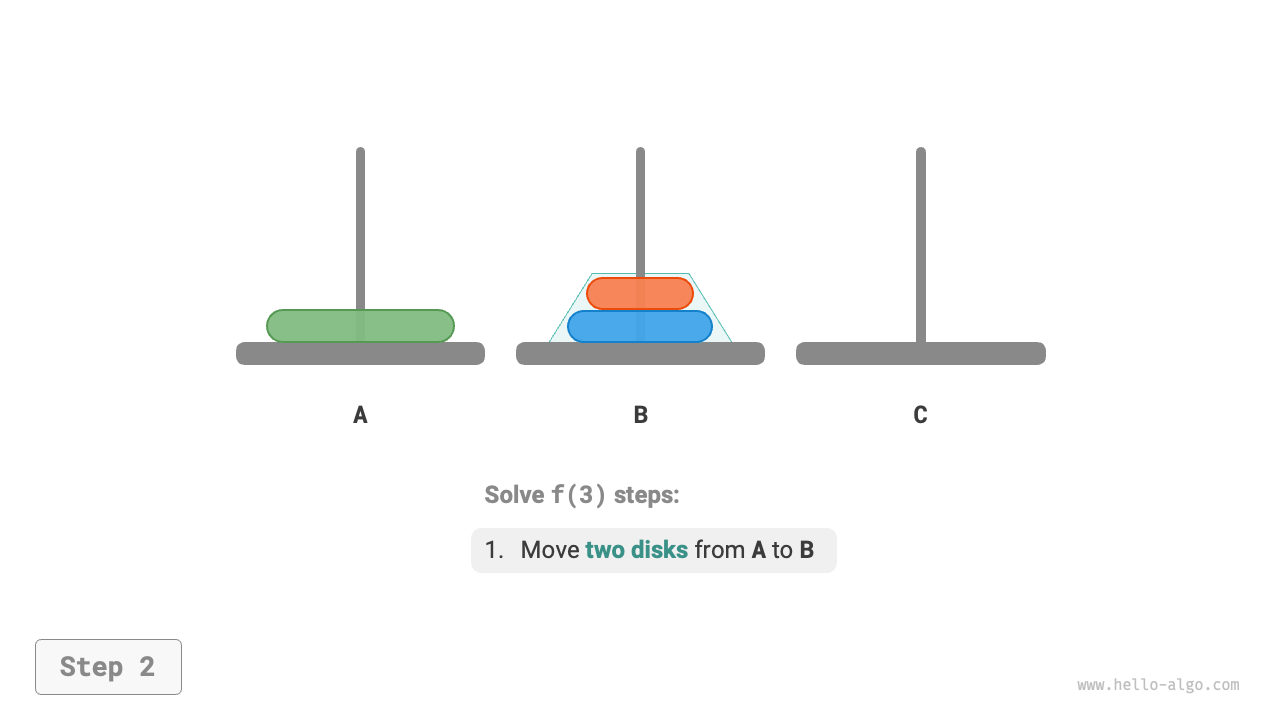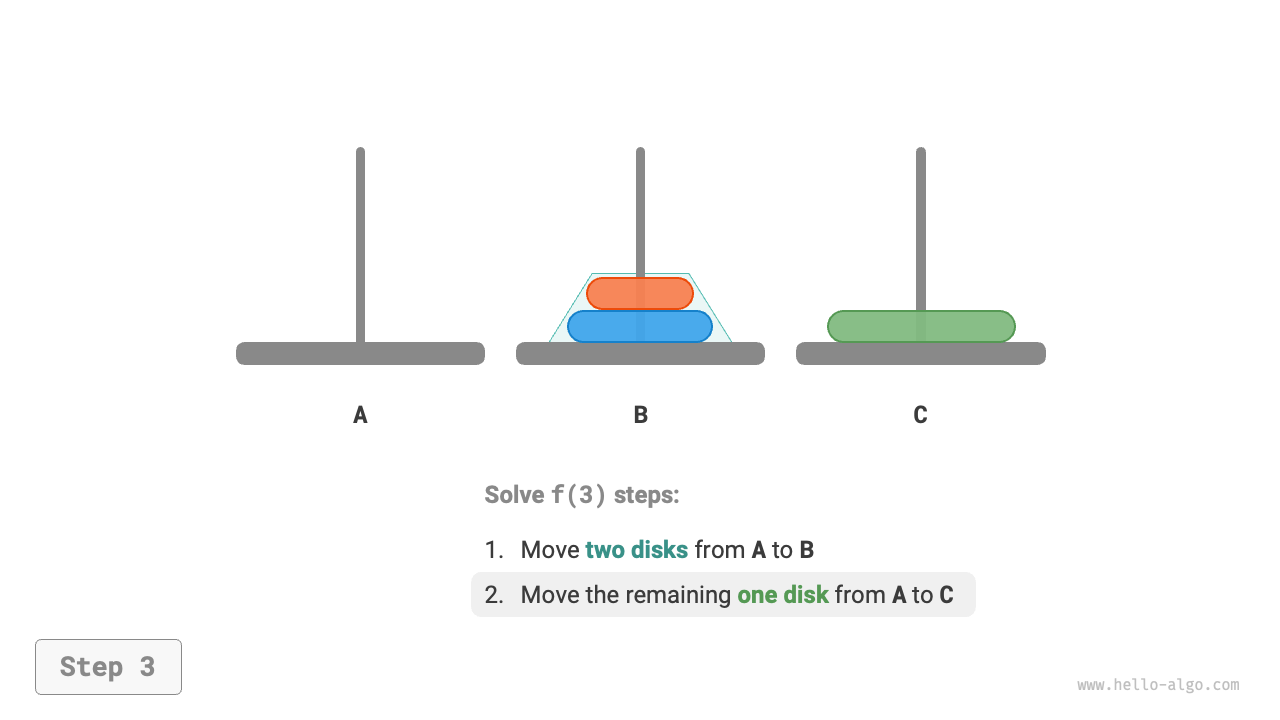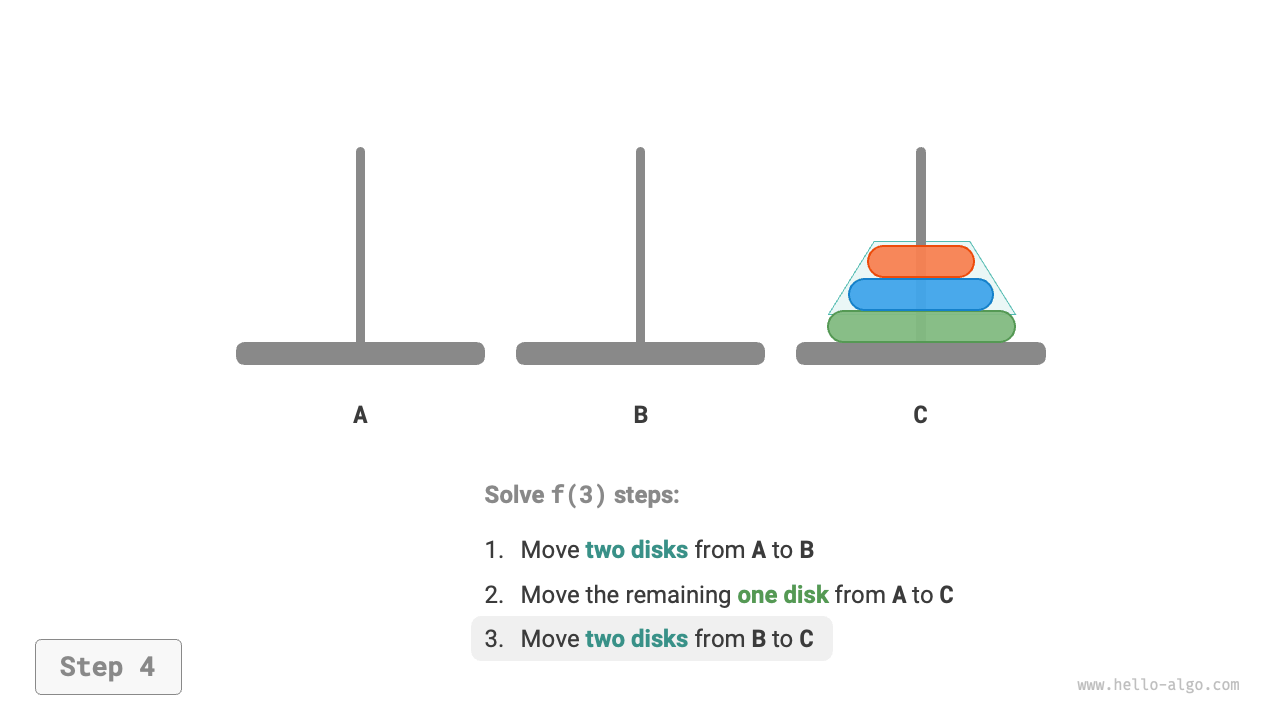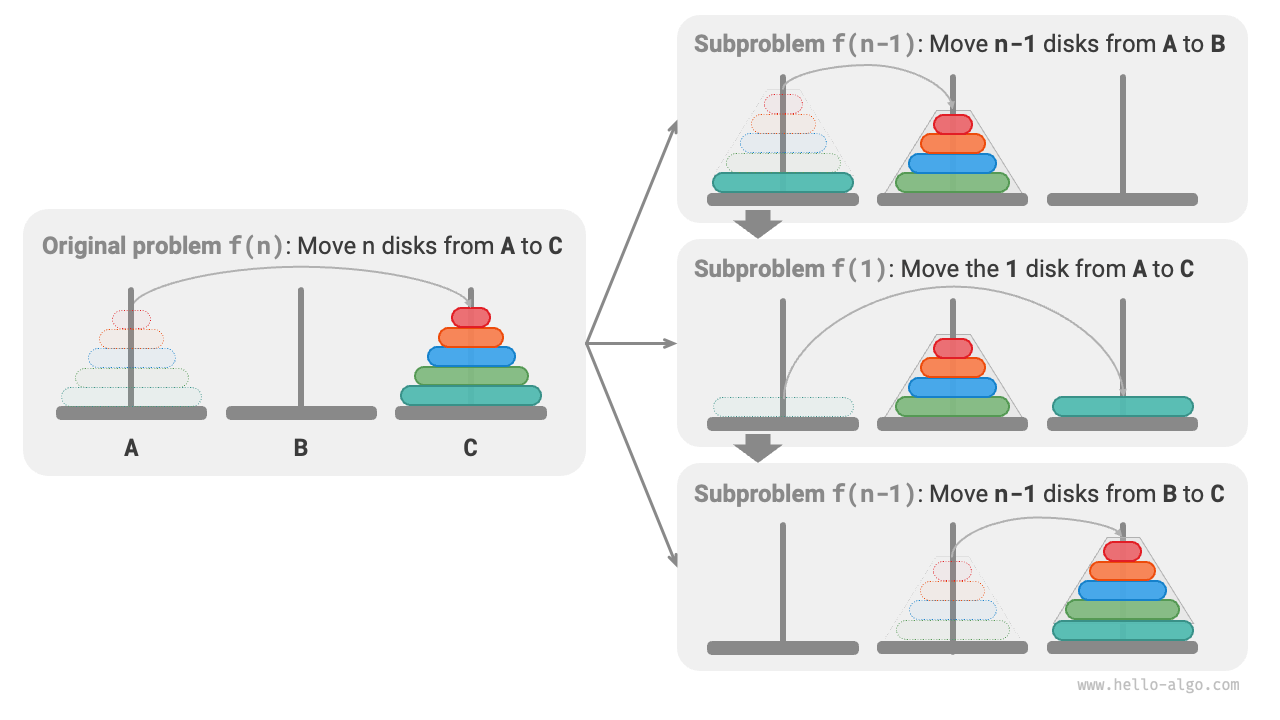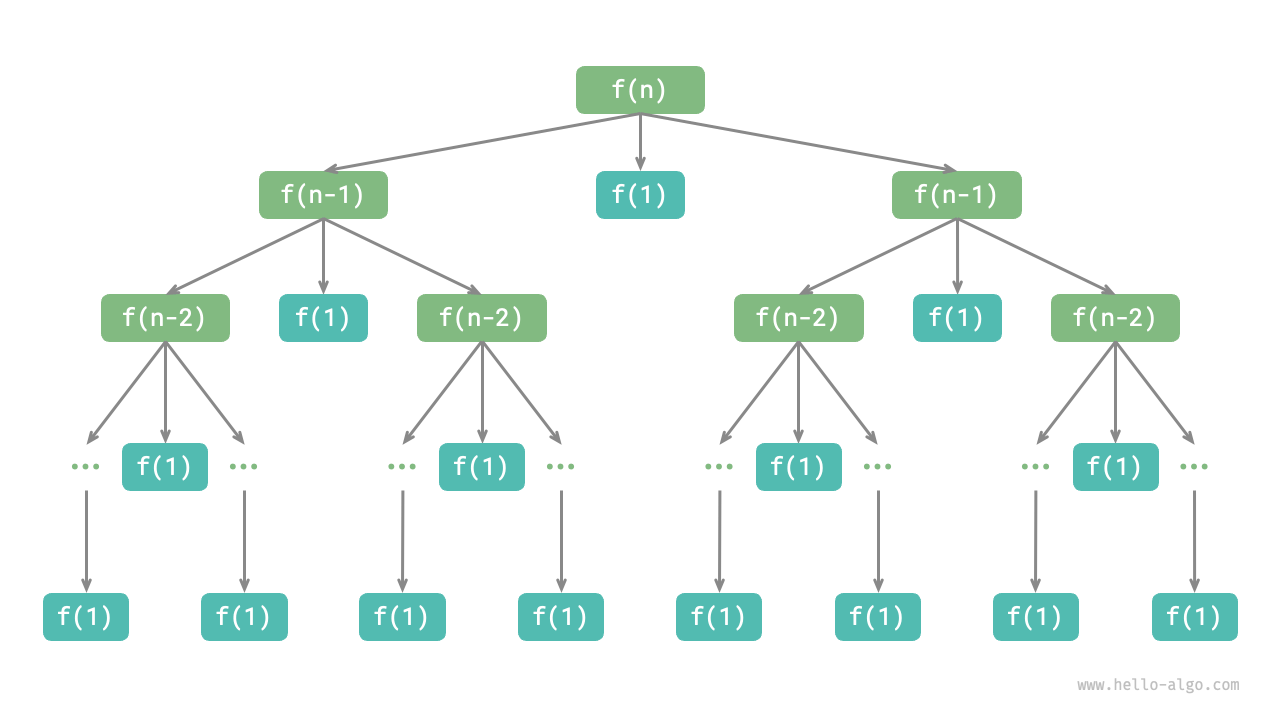12.4 Tower of Hanoi Problem¶
In both merge sort and binary tree construction, we break the original problem into two subproblems, each half the size of the original problem. However, for the Tower of Hanoi, we adopt a different decomposition strategy.
Question
We are given three pillars, denoted as A, B, and C. Initially, pillar A has \(n\) discs, arranged from top to bottom in ascending size. Our task is to move these \(n\) discs to pillar C, maintaining their original order (as shown in Figure 12-10). The following rules apply during the movement:
- A disc can be removed only from the top of a pillar and must be placed on the top of another pillar.
- Only one disc can be moved at a time.
- A smaller disc must always be on top of a larger disc.
Figure 12-10 Example of the Tower of Hanoi
We denote the Tower of Hanoi problem of size \(i\) as \(f(i)\). For example, \(f(3)\) represents moving \(3\) discs from pillar A to pillar C.
1. Consider the base cases¶
As shown in Figure 12-11, for the problem \(f(1)\)—which has only one disc—we can directly move it from A to C.
Figure 12-11 Solution for a problem of size 1
For \(f(2)\)—which has two discs—we rely on pillar B to help keep the smaller disc above the larger disc, as illustrated in the following figure:
- First, move the smaller disc from
AtoB. - Then move the larger disc from
AtoC. - Finally, move the smaller disc from
BtoC.
Figure 12-12 Solution for a problem of size 2
The process of solving \(f(2)\) can be summarized as: moving two discs from A to C with the help of B. Here, C is called the target pillar, and B is called the buffer pillar.
2. Decomposition of subproblems¶
For the problem \(f(3)\)—that is, when there are three discs—the situation becomes slightly more complicated.
Since we already know the solutions to \(f(1)\) and \(f(2)\), we can adopt a divide-and-conquer perspective and treat the top two discs on A as a single unit, performing the steps shown in Figure 12-13. This allows the three discs to be successfully moved from A to C.
- Let
Bbe the target pillar andCthe buffer pillar, then move the two discs fromAtoB. - Move the remaining disc from
Adirectly toC. - Let
Cbe the target pillar andAthe buffer pillar, then move the two discs fromBtoC.
Figure 12-13 Solution for a problem of size 3
Essentially, we decompose \(f(3)\) into two \(f(2)\) subproblems and one \(f(1)\) subproblem. By solving these three subproblems in sequence, the original problem is solved, indicating that the subproblems are independent and their solutions can be merged.
From this, we can summarize the divide-and-conquer strategy for the Tower of Hanoi, illustrated in Figure 12-14. We divide the original problem \(f(n)\) into two subproblems \(f(n-1)\) and one subproblem \(f(1)\), and solve these three subproblems in the following order:
- Move \(n-1\) discs from
AtoB, usingCas a buffer. - Move the remaining disc directly from
AtoC. - Move \(n-1\) discs from
BtoC, usingAas a buffer.
For each \(f(n-1)\) subproblem, we can apply the same recursive partition until we reach the smallest subproblem \(f(1)\). Because \(f(1)\) is already known to require just a single move, it is trivial to solve.
Figure 12-14 Divide-and-conquer strategy for solving the Tower of Hanoi
3. Code implementation¶
In the code, we define a recursive function dfs(i, src, buf, tar) which moves the top \(i\) discs from pillar src to pillar tar, using pillar buf as a buffer:
def move(src: list[int], tar: list[int]):
"""Move a disc"""
# Take out a disc from the top of src
pan = src.pop()
# Place the disc on top of tar
tar.append(pan)
def dfs(i: int, src: list[int], buf: list[int], tar: list[int]):
"""Solve the Tower of Hanoi problem f(i)"""
# If only one disc remains on src, move it to tar
if i == 1:
move(src, tar)
return
# Subproblem f(i-1): move the top i-1 discs from src with the help of tar to buf
dfs(i - 1, src, tar, buf)
# Subproblem f(1): move the remaining one disc from src to tar
move(src, tar)
# Subproblem f(i-1): move the top i-1 discs from buf with the help of src to tar
dfs(i - 1, buf, src, tar)
def solve_hanota(A: list[int], B: list[int], C: list[int]):
"""Solve the Tower of Hanoi problem"""
n = len(A)
# Move the top n discs from A with the help of B to C
dfs(n, A, B, C)
/* Move a disc */
void move(vector<int> &src, vector<int> &tar) {
// Take out a disc from the top of src
int pan = src.back();
src.pop_back();
// Place the disc on top of tar
tar.push_back(pan);
}
/* Solve the Tower of Hanoi problem f(i) */
void dfs(int i, vector<int> &src, vector<int> &buf, vector<int> &tar) {
// If only one disc remains on src, move it to tar
if (i == 1) {
move(src, tar);
return;
}
// Subproblem f(i-1): move the top i-1 discs from src with the help of tar to buf
dfs(i - 1, src, tar, buf);
// Subproblem f(1): move the remaining one disc from src to tar
move(src, tar);
// Subproblem f(i-1): move the top i-1 discs from buf with the help of src to tar
dfs(i - 1, buf, src, tar);
}
/* Solve the Tower of Hanoi problem */
void solveHanota(vector<int> &A, vector<int> &B, vector<int> &C) {
int n = A.size();
// Move the top n discs from A with the help of B to C
dfs(n, A, B, C);
}
/* Move a disc */
void move(List<Integer> src, List<Integer> tar) {
// Take out a disc from the top of src
Integer pan = src.remove(src.size() - 1);
// Place the disc on top of tar
tar.add(pan);
}
/* Solve the Tower of Hanoi problem f(i) */
void dfs(int i, List<Integer> src, List<Integer> buf, List<Integer> tar) {
// If only one disc remains on src, move it to tar
if (i == 1) {
move(src, tar);
return;
}
// Subproblem f(i-1): move the top i-1 discs from src with the help of tar to buf
dfs(i - 1, src, tar, buf);
// Subproblem f(1): move the remaining one disc from src to tar
move(src, tar);
// Subproblem f(i-1): move the top i-1 discs from buf with the help of src to tar
dfs(i - 1, buf, src, tar);
}
/* Solve the Tower of Hanoi problem */
void solveHanota(List<Integer> A, List<Integer> B, List<Integer> C) {
int n = A.size();
// Move the top n discs from A with the help of B to C
dfs(n, A, B, C);
}
As shown in Figure 12-15, the Tower of Hanoi problem can be visualized as a recursive tree of height \(n\). Each node represents a subproblem, corresponding to a call to dfs(), Hence, the time complexity is \(O(2^n)\), and the space complexity is \(O(n)\).
Figure 12-15 Recursive tree of the Tower of Hanoi
Quote
The Tower of Hanoi originates from an ancient legend. In a temple in ancient India, monks had three tall diamond pillars and \(64\) differently sized golden discs. They believed that when the last disc was correctly placed, the world would end.
However, even if the monks moved one disc every second, it would take about \(2^{64} \approx 1.84×10^{19}\) —approximately 585 billion years—far exceeding current estimates of the age of the universe. Thus, if the legend is true, we probably do not need to worry about the world ending.
